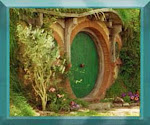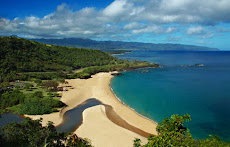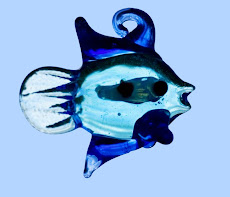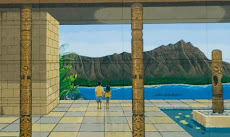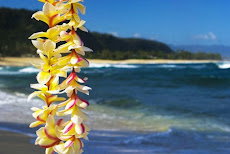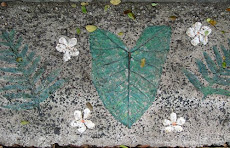|
|
| |
| (Many Paths) | ||
| An Online Newsletter Celebrating Native America | ||
| February 23, 2002 - Issue 55 | ||
|
| ||
| Thoughts of Bison Roaming Wild and Free Over the Land | ||
| by Suzanne Westerly "Canku Ota" Correspondent | ||
| credits: Photo of Danny and Jonette by Suzanne Westerly |
|
Before the bright rays of sunshine appear over Picuris Peak in Northern New Mexico to warm the secluded valley where the Pueblo of Picuris sits, Danny Sam, the Bison Manager, has already begun his day amongst the Pueblos herd of 25 bison; make that 26. "The bison usually give birth very early or very late in the day," Danny explained, "and it's rare to be able to witness a birth. It was wonderful to be there." Danny talked enthusiastically about how their herd started with the Pueblos acquisition of one pregnant buffalo cow in 1991. These big beautiful bison are very special to Danny's family, and to all the people at Picuris Pueblo. But Danny, Jonette and their two children; Daniel 12, and Maria,10 spend many hours caretaking their four-legged friends, and have a special bond with them. "We love the bison, that's for sure," said Danny. "It's been a whole learning experience for us. You don't find too much information on bison." Creating a Sustainable Economy Since Danny has taken over as Bisonkeeper, he and Jonette, who is the Assistant Bison Manager, have been focusing on finding outside sponsors to help the program grow. They hope to expand the bison's grazing land by acquiring about a thousand acres of land somewhere east of the Pueblo, "where there is some good grass, a better habitat." That means putting up a lot of fences that are "bison-proof." Since bison's natural instinct is to roam freely for their food, and because of their size and power, fences must be especially sturdy. That requires writing grant proposals for funding, which is part of Jonette's responsibilities. Educating the Youth How Do You Vaccinate a Bison? "We try to use a real subtle approach. Right now, myself and Jonette can get all of them into the corral, and we can run them through the alleyways and chute system on our own. We try to keep it real nice and easy-going and try not to upset them too much. You know, when you get a lot of people out there and everybody is yelling, I think that just really upsets them a lot. So we try to keep quiet and keep our movements down to a minimum and let them decide to go in the corral, not us pushing them!" he said. "You don't want to get any gentle nudges from them, that won't be to good if they use their horns. The bull weighs over 2,000 pounds I'm sure." Danny hopes the bison program will grow big enough to employ his children and others on the Pueblo one day so they don't have to leave the Pueblo to find jobs. "It's going to take time to develop, and I think the money will come if our heart's in the right place you know." Bison Were Essential To Life Besides using the hide as leather for clothing, footwear and teepees, there were many others uses for the entire buffalo. "There is a rawhide box made out of buffalo, and its got different things in it, like a bladder that's been washed and dried and made into a water container, another one that's been dried and folded and made into a pouch for carrying porcupine quills. The hooves, the horns, made into bowls, into spoons, ladles and tools. Bones were used for painting with, and for toys. ITBC has a poster available that shows the bison's anatomy and all the ways the body parts were used, probably thirty uses. Everything was used even the undigested grass in their belly, it was used for paint and the manure was used for fuel in the old days,” said Danny Sam, Bison Manager at Picuris Pueblo in New Mexico. The Intertribal Bison Cooperative Excerpts taken from ITBC's Mission Statement, & History They gathered in the Sacred Black Hills of South Dakota on a cold February day in 1991. With only four days prior notice, nineteen tribes from all four directions braved the harsh Dakota winter to attend. Lakota representatives from most of the reservations in South Dakota were there, as well as the Crow, Shoshone-Bannock, Gros Ventre /Assinoboine and Blackfeet Nations of Montana. Various Pueblo representatives from New Mexico pulled in, and the Winnebago, traditionally called Ho Chunk, from both Nebraska and Wisconsin came. Choctaw Nation of Oklahoma, and some as far west as Round Valley of California arrived. Some of these tribes were historically enemies, but now they unite for a common mission . . . Our History . . . The American buffalo, also known as bison, has always held great meaning for American Indian people. To Indian people, buffalo represent their spirit and remind them of how their lives were once lived, free and in harmony with nature. In the 1800's, the white-man recognized the reliance Indian tribes had on the buffalo. Thus began the systematic destruction of the buffalo to try to subjugate the western tribal nations. The slaughter of over 60 million buffalo left only a few hundred buffalo remaining. Without the buffalo, the independent life of the Indian people could no longer be maintained. The Indian spirit, along with that of the buffalo, suffered an enormous loss. At that time, tribes began to sign treaties with the U.S. Government in an attempt to protect the land and the buffalo for their future generations. The destruction of buffalo herds and the associated devastation to the tribes disrupted the self-sufficient lifestyle of Indian people more than all other federal policies to date. To reestablish healthy buffalo populations on tribal lands is to reestablish hope for Indian people. Members of the Intertribal Bison Cooperative (ITBC) understand that reintroduction of the buffalo to tribal lands will help heal the spirit of both the Indian people and the buffalo. The Intertribal Bison cooperative was formed in 1990 to coordinate and assist tribes in returning the buffalo to Indian country. In April of 1992 tribal representative gathered in Albuquerque, New Mexico. It was at that meeting that the Intertribal Bison Cooperative (ITBC) officially became a recognized tribal organization. Today ITBC has a membership of 42 tribes with a collective herd of over 8,000 bison. Membership of ITBC remains open and there is continued interest by non-member tribes in the organization. "We recognize the bison is a symbol of our strength and unity, and that as we bring our herds back to health, we will also bring our people back to health."
|
|
| ||
|
| ||
|
| ||


 PICURIS PUEBLO, NM - "The government used the bison to take land away from Indian people, now we want to use the bison to acquire the land back for ourselves. That's our goal. We'd like to see the bison roaming again. Strong herds, not just little ranch herds, we want to see wild herds. They are good for the land."
PICURIS PUEBLO, NM - "The government used the bison to take land away from Indian people, now we want to use the bison to acquire the land back for ourselves. That's our goal. We'd like to see the bison roaming again. Strong herds, not just little ranch herds, we want to see wild herds. They are good for the land." 
